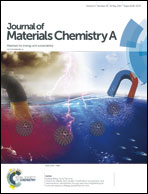Discrete supertetrahedral CuInS nanoclusters and their application in fabrication of cluster-sensitized TiO2 photoelectrodes†
Abstract
Supertetrahedral clusters of main-group metal chalcogenides (Tn) have been well-studied for decades. Most of them are polymerized 2D or 3D structures and have been used as porous materials for ion exchange and as ion conductors. Large discrete T5 clusters of main-group metal chalcogenides are attractive in that they might be used as nanocluster materials with uniform size and definite structures. However, until now, discrete T5 clusters have been reported only in the solid state and their dispersed solution has not yet been obtained due to their low solubility in common solvents, thus not to mention their application as nanodots. We prepare a crystal compound with discrete T5 CuInS clusters using a simple and economical way. A solution of the T5 clusters was obtained by a strategy using a medium with strong ionic strength to overcome the strong ionic force in crystals. The discrete T5 clusters in solution is proved by HRTEM and ESI-MS. The nano-T5 CuInS clusters can be easily modified on a TiO2 electrode by a wet process and the clusters show excellent photo-sensitive properties tested by photocurrent and photocatalysis.



 Please wait while we load your content...
Please wait while we load your content...